People may not think much about cleaning their dishwasher. After all, it literally goes through a cycle of cleaning every time it runs. The truth is, you should be cleaning your dishwasher in order to reduce mold and bacteria growth. In this tutorial, we’ll discuss how to clean a dishwasher, how to clean a dishwasher filter, and how to deal with orange residue in a dishwasher. Let’s get started.

You would think the inside of your dishwasher would be clean, right? After all, it cleans dishes every day with dishwashing detergent. But dishwashers use high temperature water and salts (found in dishwashing detergents)… and guess what thrives in that environment? Mold and yeast! A study was conducted which found 70% of dishwashers contained yeast and 10% contained fungi which could pose a threat to human health! (Source) Not only that, the dishwasher filter contains food debris which creates an environment for bacteria growth.
Can I be honest with you? This is a classic case of “Do As I Say, Not As I Do”… You should clean a dishwasher every month… but I hadn’t cleaned mine in a couple years… and it showed. I am not one to shy away from sharing embarrassing pictures of scum and stains; and today will be no different. I will show you what our dishwasher looked like before cleaning and what it looks like now.
What You Need to Clean A Dishwasher

Affiliate links may be used. Please see our advertising disclosure for more information.
Ingredients Needed to Clean A Dishwasher
- Vinegar– Vinegar kills 82% of molds, so that’s the reason we use it to clean the dishwasher
- Baking Soda– Another mold killer 🙂 Baking soda will also absorb odors in the dishwasher helping to deodorize and freshen things up
- Dish Soap
Supplies Needed to Deep Clean A Dishwasher
- Toothbrush (Not your own!)
- Non-Scratch Scour Pad– You may not need a scour pad, but it’s helpful if there are any areas with a caked-on mess.
- Liquid Measuring Cup– Make sure it’s dishwasher safe
How to Clean A Dishwasher Using Vinegar & Baking Soda
First thing’s first: empty the dishwasher.
How to Clean A Dishwasher Filter
Most dishwashers have a filter located at the bottom of the appliance. The filter traps smalls bits of food and debris in order to keep the dishwasher running properly. A dishwasher filter needs to be regularly cleaned to remove the grime that builds up.
Start by locating your filter and removing it (typically by turning it counter-clockwise).

Once the dishwasher filter has been removed, run it under warm water to loosen any debris. Then grab a soft bristle toothbrush and gently scrub the filter with a little dish soap. Do not use firm bristle brushes or scour pads as these can damage the filter.

Once you have given the dishwasher filter a thorough scrub, rinse it in warm water and return it to the dishwasher. Check out our dishwasher filter before and after cleaning!
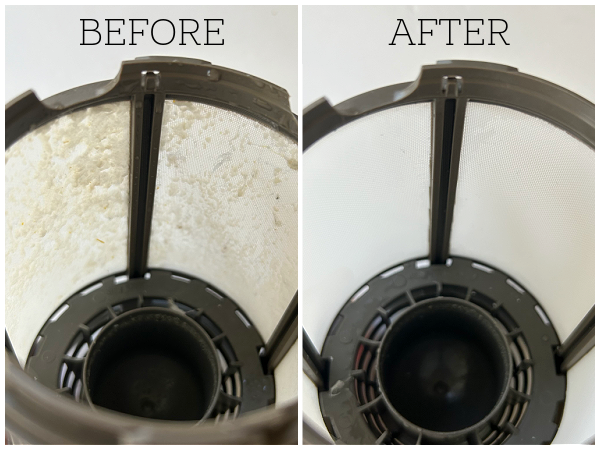
How to Clean the Rubber Seal of A Dishwasher
The dishwasher’s rubber seal was the place the study (mentioned above) found the most cases of fungi and yeast, so make sure you take time to really clean this area. I am not sure what happened on the right side of our dishwasher (as I load from the left), but the rubber seal (and the door area that butts up to the rubber seal) was caked with food. It was absolutely disgusting! I grabbed a non-scratch scour pad, loaded up with some dish soap and gave it a good scrub.

Once I cleaned the areas with visible gunk, I used a toothbrush (dipped in vinegar) to scrub the rubber seal.
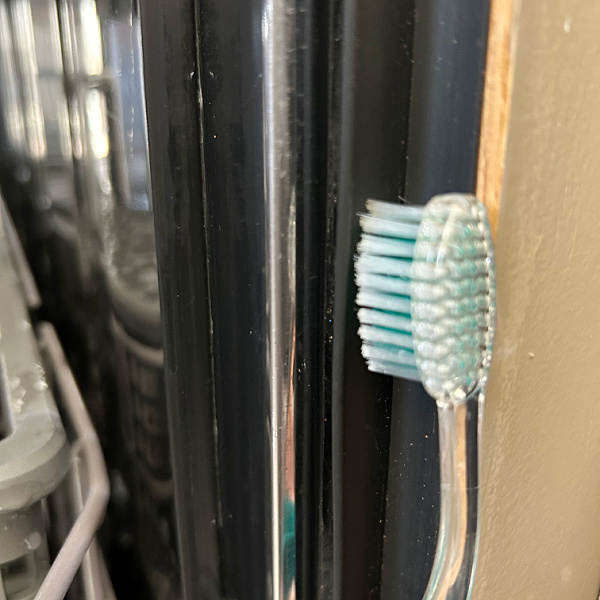
Note that some dishwashers (including ours) have a double seal: one on the outside sitting against the door, and one on the inside; so make sure to clean them both.
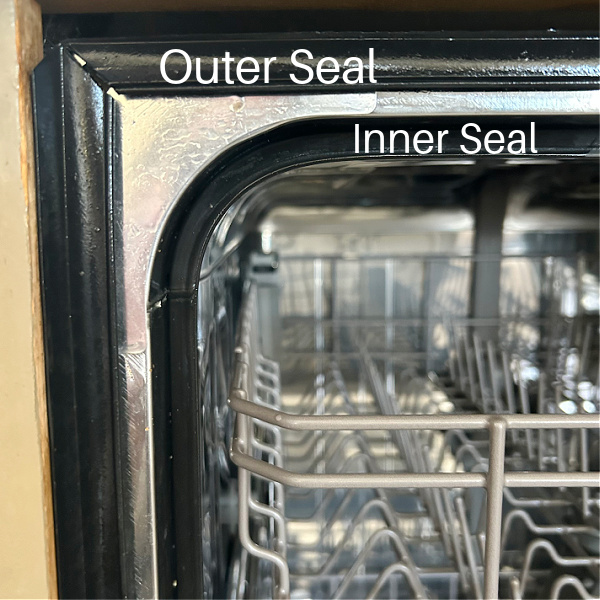
Here is our dishwasher door and rubber seal before and after cleaning.
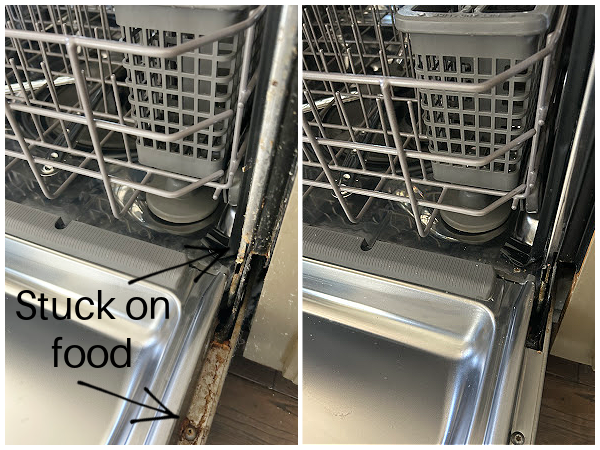
How to Deep Clean the Inside of A Dishwasher
With the dishwasher filter and rubber seal complete, it’s time to deep clean the inside of the dishwasher. Start by pouring 2 cups of vinegar into a 2 cup glass measuring cup and place it on the top shelf of the dishwasher; then run your dishwasher through a normal wash cycle.
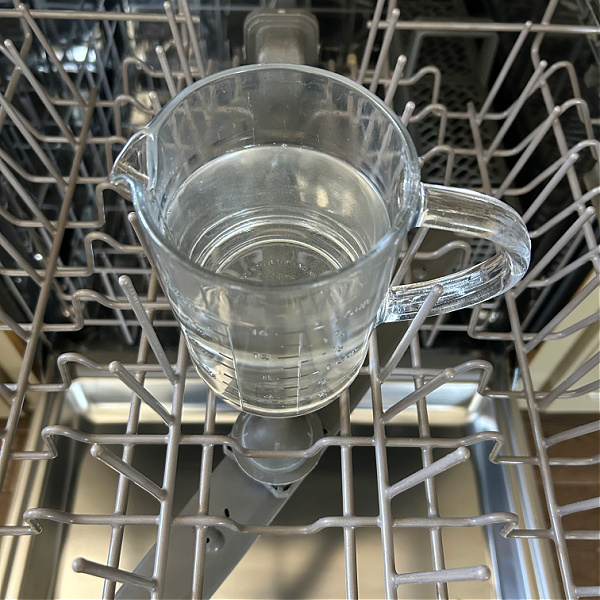
Once the cycle is done, remove the liquid measuring cup (careful, it might be hot) and sprinkle 1 cup of baking soda on the bottom of the dishwasher; then run it through a quick wash/short cycle.

How to Clean the Outside of A Dishwasher
Cleaning the outside of a dishwasher will depend on its finish. If you have a stainless steel dishwasher, you can clean the outside with a stainless steel cleaning cloth and a little olive oil. I have a full tutorial on how to clean stainless steel that may be helpful. Other finishes may only require a quick wipe with water and dish soap.

Your dishwasher is now clean!
Common Questions About Cleaning A Dishwasher
Why is There Orange Residue in My Dishwasher?
Years ago, I posted an image of this orange slime in our dishwasher and asked my readers if they knew what it was.

I had tried googling “orange gunk in dishwasher” and came up with nothing. This mysterious orange residue would easily wipe away, but kept returning.
Luckily, others came through for me, sending me links to articles that confirmed this orange slime in our dishwasher was most likely a biofilm caused by the bacteria Serratia marcescens. Yuck!
Unfortunately, biofilm isn’t an easy thing to get rid of. Not only do you need to remove all the film (or it’ll keep coming back), you also need to kill the bacteria growing within the film. Honestly, I was never able to completely keep the orange residue from coming back. Our dishwasher ended up breaking and we got a new one. I haven’t had an issue since.
The best way to prevent Serratia marcescens from forming in the dishwasher is to regularly clean the dishwasher filter, seal and inside as these areas contain food residue and oils that feed the bacteria.
How Often Should I Clean A Dishwasher?
It is recommended that you clean your dishwasher once a month. This includes cleaning the dishwasher filter. As I mentioned above, it had been a long time since I last cleaned our dishwasher… and it shows. Regularly cleaning a dishwasher helps keep it running smoothly, and also minimizes mold and bacteria growth.
Love it? Pin it!



We have EXTREMELY hard water from our well. My husband researched my dishwasher and found that running a quick cycle using citric acid crystals, filling both detergent cups as full as possible and NO heated dry… cleans this. I usually only need to wipe around the seals afterward.
Do you think the vinegar & baking soda cleanse is strong enough to cut through a really bad hard water residue?
The orangey-slim is caused by Serratia marcescens, a bacteria that has what’s called an “adhesive cell matrix,” which means it thrives as a colony and sticks together, so it appears as pink or orange slime plaguing your toilet, tub, and dishwasher.
These bacteria love fatty residue — so the grease that gets into your dishwasher and food substances left behind help it thrive. It’s generally not harmful, but immune-compromised people and kids can be susceptible to infections, so don’t ignore it. It needs scouring and disinfecting, but don’t use bleach, as it can damage your dishwasher.
If your dishwasher DOES NOT have a stainless steel interior you can do a bleach wash by adding 1 cup of bleach to the bottom of the dishwasher then running a full wash cycle. Do NOT do this step if your dishwasher has a stainless steel interior. Bleach can and will permanently damage and discolor stainless steel!
If your dishwasher has stainless steel then you will need to do a vinegar/baking soda cleanse every few days to retard the growth of this bacteria.
Hope this helps. 🙂
How much vinegar and baking soda should you add?
Thanks for the information. I have completely cleaned my dishwasher before, however, it’s been a while. I have that orange slime buildup which I don’t remember ever being to this degree. It is in the water arms and absolutely in everything. I can do my best to get little brushes in there but I know I won’t get it all. It’s just disgusting. Any suggestions to totally rid the washer of it? Im using liquid Cascade and Finish fr washng dishes. Is this part of the problem? Would you recommend something else after I get it clean?
I had to take all parts outside and pressure wash all the holes and oraphises
Thank you for the dishwasher cleaning instructions. I did exactly that, yesterday afternoon and no more sediment on the walls of my appliance. Will do it a few times a year!
Much gratitude!
I am looking to make dishwasher tabs, do you have a recipe?
It’s a bacteria, we get it in the bathroom / shower room, basically it thrives in damp environments which is probably why the dishwasher gets it. It cleans off easy enough though
It might be a form of yeast:
https://www.healthline.com/health-news/children-is-fungus-lurking-in-your-dishwasher-070313#2
It’s a form of mildew. I used a toothbrush along with Thieves cleaner,from Young Living, and it came right off. I don’t use bleach anymore since it’s so harmful to breathe and doesn’t kill as many germs as the Thieves cleaner.
It is the bacteria serratia
/www.dsmh2o.com/tag/dishwasher-film/
I have that in my dishwasher and I have always believed it to be grease and cheese buildup. We go through a fair amount of pasta and Mac and cheese at our house. I just scrub it with dawn dish soap every month or so. It is gross.
A couple weeks ago I went in with diluted bleach. I typically avoid using bleach because it’s SO strong, but I was desperate. It actually seemed to do a pretty good job, and it hasn’t built back up… yet. Hoping that might have fixed the problem, because you are so right… it’s gross.
I know this is an old post, but I’d be willing to bet it’s serratia. It forms a biofilm especially in places where it’s damp and there is grease or another food supply. If you scrub it really well and then let it soak in some bleach you can probably get rid of it. It can be really difficult to remove completely because if you don’t get it all it can come back. 🙁
Thanks for your insight Sarah! I will definitely look into this and see if I can’t get it to stop coming back over and over again.
Does the vinegar not remove the serratia?
I have that orange slime in my dishwasher. It didn’t appear until I started using these: Finish Gelpacs Dishwasher Detergent, Orange Scent. I’m going to try your cleaning method and see if it will help.
That’s very similar to what we’ve got going on. It’s only in the dishwasher. The coloring and distribution look the same. My younger son has a tendency to take cups and bowls into the back yard, scoop dirt, and leave them out there. I think the problem started when I washed some of these items. I was pretty successful getting it cleaned by using bleach.
Try looking up iron bacteria. That leaves an orange slime on things at my house
Wow, that iron bacteria does kinda look like what I’ve got going on, but this slime isn’t sticky as described on wikipedia ( 🙂 ), and it’s ONLY happening in the dishwasher, not in my sinks, toilets, showers, etc. Not sure if the iron bacteria can just infest one area or not. Thanks for the information. I’ll keep researching the iron bacteria further.
It looks like food , pasta sauce, maybe? Pasta sauce is difficult to get off anything. Thanks for all the awesome cleaning tips.
Thank you for the useful tips & tricks. very helping article 🙂
You are so welcome! Enjoy your day!